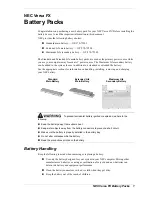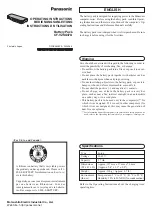
www.lesterelectrical.com
2
01413H
CAUTION:
BE SURE BOTH THE AC
VOLTAGE SELECTOR SWITCH AND THE
BATTERY MODE SWITCH ARE PROPERLY SET
BEFORE USING THE CHARGER. CHARGER
MAY BE DAMAGED, OR BATTERY MAY BURST
CAUSING PERSONAL INJURY IF SWITCHES
ARE NOT SET PROPERLY.
Locate the charger in an accessible spot where the
AC supply cord can be easily reached. Provide
adequate ventilation for the charger. The convection
cooled design requires an unobstructed flow of
cooling air for proper operation. Keep all charger
ventilation openings at least two inches (2") (5cm)
away from all other objects. DO NOT allow clothing,
blankets, or other material to cover charger.
WARNING: TO REDUCE THE RISK OF FIRE,
DO NOT USE CHARGER NEAR FLAMMABLE
MATERIALS OR VAPORS.
DANGER: RISK OF ELECTRIC SHOCK!
CONNECT AC SUPPLY CORD DIRECTLY TO
GROUNDED, 3-WIRE OUTLET. DO NOT TOUCH
UNINSULATED PORTION OF DC OUTPUT
TERMINALS OR BATTERY TERMINALS. DO
NOT EXPOSE CHARGER TO RAIN OR POWER
WASH. REPLACE DEFECTIVE CORDS, WIRES
OR CONNECTORS IMMEDIATELY.
Do not operate this charger if it has received a sharp
blow, was dropped, pulled off a shelf, or otherwise
damaged in any manner. Refer to a qualified
service agent.
EXTENSION CORD REQUIREMENTS
Always use a three-conductor, No. 14 AWG (1.5mm)
Heavy Duty cord with ground, properly wired, in
good electrical condition and keep it as short as
possible. Make sure the pins on the plug of the
extension cord are the same number, size and
shape as the AC plug of the battery charger. The
use of an improper extension cord could result in a
risk of fire or electrical shock. Locate all cords so
they will not be stepped on, tripped over or
otherwise subjected to damage or stress.
GROUNDING INSTRUCTIONS
This battery charger must be grounded to reduce the
risk of electric shock. This charger is equipped with
an AC supply cord, having an equipment-grounding
conductor which must be connected to the ground
prong of an appropriate plug for the AC voltage
being used. This plug must be connected to an
appropriate AC outlet which is properly installed and
grounded in accordance with the National Electrical
Code (U.S.) and all local codes and ordinances.
DANGER: IMPROPER CONNECTION OF THE
EQUIPMENT-GROUNDING CONDUCTOR CAN
RESULT IN A RISK OF AN ELECTRIC SHOCK.
The conductor with insulation having an outer
surface which is green, with or without yellow
stripe(s), is the equipment-grounding conductor. Do
not connect the equipment grounding conductor to a
live terminal. If the supply cord of this equipment is
damaged, it must be replaced with an original
equipment manufacturer supplied cord or other
approved cord by a qualified/licensed person.
NORMAL OPERATION - STATIONARY OR SHELF
USE
Refer to the instructions on the charger before each
use.
1.
Connect input cord to properly grounded supply
outlet that matches the AC voltage select switch
setting. Set power switch to "AUTO, (l)" for
charger to operate.
2.
Connect the output charging plug to the correct
battery system as specified. Ensure the battery
mode switch is set correctly for the type of lead
acid battery to be charged.
3.
The charger will start after a short delay,
"CHARGING" light will glow, transformer hum
and ammeter indicate initial charge rate.
WARNING: LEAD ACID BATTERIES
GENERATE GASES WHICH CAN BE EXPLOSIVE.
CHARGE ONLY IN WELL VENTILATED AREAS.
DO NOT DISCONNECT CHARGER DC OUTPUT
TERMINALS FROM BATTERY WHEN CHARGER
IS ON. THE RESULTING ARCING AND BURNING
COULD CAUSE THE BATTERY TO EXPLODE.
KEEP SPARKS, FLAME AND SMOKING
MATERIALS AWAY FROM BATTERY.
If the charger must be stopped, disconnect the
AC supply cord from outlet.
4.
Monitor the ammeter for correct charge rate.
The initial charge rate should be approximately
20 amps. If the battery has not been
discharged, or the AC supply voltage is lower
than 100/200 volts, the initial charge rate may be
less than 20 amps.
The charge rate will decrease as the battery
reaches full charge. On a liquid electrolyte
battery, the charge rate will decrease to about 8
amps and remain there until the charger turns
off. As the battery ages, the charge rate may no
longer decrease to the 8 amp finish rate. This is
normal and the charger will still determine when
the battery is charged to its optimum and then
turn off.
























